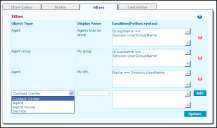Filters
The Filters tab is used to create filters which are used to limit the type of data displayed in your web statistics view. These filters are written using the Python programming language syntax, and must be a Boolean expression (i.e. resolve to a true or false result when the data is being displayed in the web statistics portal). Any filter result applied to a statistic which resolves to true will be displayed, all others will be ignored.
When creating a filter, you can use values from the metric to be displayed to assist in filtering. Depending on the type of metric to be displayed (Agent, Agent Group, Service, or Contact Center) you have different properties you can evaluate:
|
Object |
Object Property |
|
Agent |
Name |
|
DisplayName |
|
|
GroupName |
|
|
AgentName |
|
|
FirstName |
|
|
LastName |
|
|
State |
|
|
Reason |
|
|
TimeInCurrentState |
|
|
AgentGroup |
Name |
|
DisplayName |
|
|
GroupName |
|
|
Service |
Name |
|
DisplayName |
|
|
ContactCenter |
Name |
|
DisplayName |
Though there are a wide variety of filters which can be written, the most logical ones are used to limit data to a specific user, user group or service. This can be done by adding a filter which compares the current statistical metric properties with a literal value:
GroupName=="Demo agent group"
If you wish to have the filter change depending on which user is logged in, it is useful to use the Session object, which contains values relating to the currently logged in user.
GroupName==Session.GroupName
This will filter any statistics shown to relate to the currently logged in user's group. This is valuable if you want a single filter to work for all your supervisors so they each see their own team, as an example.
The Session object supports the following properties:
•UserName - Represents the user name used to log into web statistics.
•UserGroupName - Represents the group that the UserName is associated with.
•ForUser - Represents the "ForUser" value that was selected when a drill down link was chosen. It will default to the UserName if no links have been selected.
For information on Python, visit http://www.python.org.
Creating Filters
To Create a Filter:
1.In the Object Type column, select the view part object (Agent, Agent Group, Service, or Contact Center) for which you want to create a filter.
2.Type a name for the filter in the Display Name field. This filter name displays only in the Web Statistics configuration pages of the Management Portal.
3.In the adjacent Condition column text box, type the syntax of the condition(s). The conditions you set in the text box apply only to the view part object selected in the Object Type column.
4.Click the Add button. The page refreshes, and the condition displays in the table.
5.Click the Update and Commit Changes buttons to enact the changes.
To Remove a Filter:
1. Click the red x icon next to the filter.
2.Click OK to confirm the deletion.
3.Click the Update and Commit Changes buttons to enact the change.
